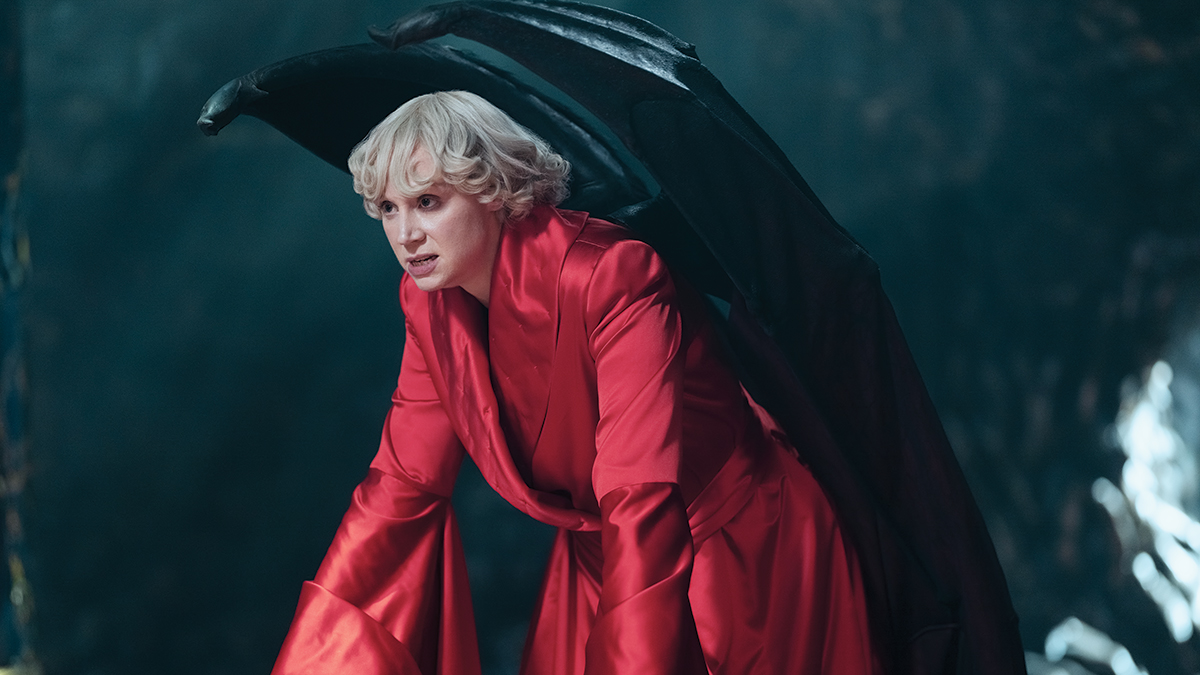The Sandman: Dressing Lucifer and Other Costume and Prop Secrets from the Netflix Series
Property master Gordon Fitzgerald and costume designer Sarah Arthur delve into the intricacies of their work on Netflix's The Sandman.

This article is presented by: 
The art of props and costumes can sometimes be an invisible one for viewers, only really noticeable when the team does something that feels wrong. The devil is in the detail—those small pieces that appear on the set, whether it’s a flagon appropriate to the 1600s or a vibrant costume that sets the tone of the scene. When everything comes together to create the right atmosphere, the props and costumes feel seamless, an enhancement of the world.
While their names might be unfamiliar, The Sandman costume designer Sarah Arthur and property master Gordon Fitzgerald have both worked on high-profile projects. Arthur has served as costume designer on such projects as Sherlock and A Discovery of Witches. Fitzgerald worked with The Sandman actor Gwendoline Christie as the property master on Game of Thrones, as well as on previous Neil Gaiman project Good Omens. “It’s been a lot of Gaiman for the last three years!” Fitzgerald jokes.
Den of Geek spoke to Arthur and Fitzgerald to take a look behind the scenes at some of the primary props and costumes that viewers will notice when the comic book adaptation hits their screens.
The Helm
As Sandman fans know, the first story in the graphic novels follows Dream, recently freed from imprisonment, as he works to regain his three items of office in order to restore him to his former power. One of the most iconic of these is the Helmet of Dreams, which covers his full face. Typically, a piece like this would be the duty of the props department, but for The Sandman, because it’s important for Dream to wear it, the design and creation were handled by the costumers. “That was quite a challenge,” says Arthur.
The props and costumes teams worked together closely on the helmet because it “had to appear in a bag, kind of like an old-fashioned carpetbag,” Fitzgerald says. “We had to work with costume to make sure that what they had fit into the bag we were going to provide.” The solution? The helm was designed as a foldable piece. “It was about four feet long,” Fitzgerald notes, so if it hadn’t been able to fold, “the bag would be enormous!”
Arthur also notes that the team, at the behest of Allan Heinberg and Neil Gaiman, made every effort to stick close to the comics. She says that viewers will see some very close matches to the original art: “When Dream came down into Roderick’s house, we laid out the cloak like it was laid out in the comic. We did little things like that.”
Tom Sturridge, the actor playing Dream, has a number of costumes over the course of the season. “I loved Dream’s costumes because they were so varied,” says Arthur. “His journey was vast. We went from early centuries through to modern-day London, [as well as] the dream world. We had to alter things to accommodate those sets.” The sets’ importance in establishing both costumes and props is echoed by Fitzgerald: “The set design was so critical to the look of [the show].”
The Sand and the Ruby
Dream’s two other items of power are a bag of magical sand and a ruby, which, in his absence, has been manipulated by a human magician.
The ruby is Fitzgerald’s favorite among all the props the team created.
“It changed, and it glowed, and it did different things,” he says. The ruby seen on screen is a combination of a physical prop and CGI. According to Fitzgerald, at the beginning of a project, the visual effects team presents the props department with a wishlist of items they’d like to see. Most of the items that the actors physically interact with have a physical component, which the visual effects crew will manipulate in post-production. The ruby, however, had its own special effects. In order to create illumination from the prop itself, Fitzgerald’s team worked with the electricians. “[The electrical department] helped us by making it glow in different ways,” he explains. “There was always a lot of magic going on behind the scenes just to make it do whatever it had to do.”
Matthew The Raven
Sometimes a character is also a prop. One such character is Matthew the Raven, voiced by Patton Oswalt. Once a mortal human, Matthew has been transformed into a raven to be a servant of Dream. The fully mobile, very realistic-looking bird depicted on screen isn’t just a product of CGI, though—it’s a combination of a physical object and animation. “We have a physical prop that we offer up,” Fitzgerald explains, “and then CGI and special effects are involved. So often, it’s something that the actor needs to interact with, and the visual effects will take it from what we have and create their world.” The result in the episodes is a seamless version of the character, a compellingly believable talking bird who comes through with aid just when Dream needs him most.
Changing Times
One of the greatest challenges of the series is that it spans such a long period, with later episodes featuring a time-lapse across seven centuries. While much of the series takes place in either modern-day or fantastical settings, like Dream’s kingdom and Hell, there are scenes that require research into different periods. Fitzgerald, who worked on Game of Thrones, says that shows in a single setting are “easier because you’re just doing one period.”
In episode six of The Sandman, the “tavern sequence” begins in the 1400s, with Dream and Hob Gadling—whose death has been forstalled by Dream’s sister Death in an experiment about whether mortals would enjoy immortality—revisiting the same setting every hundred years. Each time, the sets had to be redressed, and the costumes and props brought up to period. “You’ve got to have your facts right,” says Arthur. “I kept getting confused between 1589 and 1689 because they’re sort of similar—but they’re not at all. So it was very important to do research.”
It’s not all about accuracy, though. “You’re always trying to make it interesting, as well,” says Fitzgerald. “So if you’ve got a scene from the 1700s, then you’ve got to give the actors in the background something to work with that makes the scene appealing, beyond addressing the period. There’s historical reference, but you end up making up things that you [hope will] work.”
Arthur notes that in some cases, historical references are slim. “When you go back hundreds of years, it’s not documented in pictures,” she says. In addition, the background cast in the tavern sequence are commoners rather than nobles, and there are far fewer references for people who weren’t wealthy (they couldn’t afford things like portraits). “You have to read up on it,” she says.
Lucifer: Ruler and Warrior
In order for Dream to retrieve his helm from the demon who stole it, he must battle Lucifer in a contest of the mind that has a very physical, intense engagement between the two actors. When Dream is first greeted by Lucifer, the ruler of Hell wears bright white robes; then, as the battle between them begins, Lucifer suddenly dons black armor. The striking contrast is an invention of the costume department and Gwendoline Christie, the actor who portrays Lucifer.
“I think it’s very, very important for actors to have their say [in the look and feel of their costumes]”, Arthur says. “A lot of actors build their characters through their costumes, so it’s a really important part of the process [to] sit down, talk, and come up with ideas.” The two contrasting-color costumes for Lucifer were created by Christie’s partner, fashion designer Giles Deacon. “He’s an incredible costume designer,” says Arthur.
Lucifer’s costumes also include a vivid red robe, adding another contrast to Christie’s pale golden hair and the character’s matte black wings. Lucifer is intentionally designed to look androgynous, something that mimics the comics, and is one of several androgynous, non-binary, or gender fluid characters in the show.
To make sure that sense of gender came across in the visuals, “I did a lot of work on all the characters right at the beginning, before we started shooting,”
Arthur says. “We looked at lots of androgynous characters from the past—people like David Bowie, for example, who in the ’70s did his own thing. It was massive, because we had to be very sensitive towards everything, but we had some amazing actors playing those parts.”
Sticking to the Source
Although comic-book physics don’t always translate well to the real world, it was vital to the whole team to be able to honor the source material. “We tried to stick with the comic as much as possible,” Arthur explains. She notes that for the character of Lucienne, the head librarian of Dream’s Castle who is played by Vivienne Acheampong in the series, “we mimicked the costumes, the glasses,” and kept the look as close to the comic as possible, even though the character has been gender-swapped. Among her favorites are the costumes for Cain and Abel, also closely drawn from the comic: “The first costumes you see are quite scruffy, but further along, they’re much smarter.”
Fitzgerald also addresses the importance of staying close to the source material. “The trick is to make it appear that [any prop] is something that could be from the comic,” Fitzgerald explains. The show is “for the fans of Sandman,” he continues. “If the episodes do justice to that, then that would be a great achievement. The set design, the costume design, and then all the smaller elements contribute. So if the fans are happy at the end, then hopefully we’ve done a good job.”
The Sandman is streaming now on Netflix.
